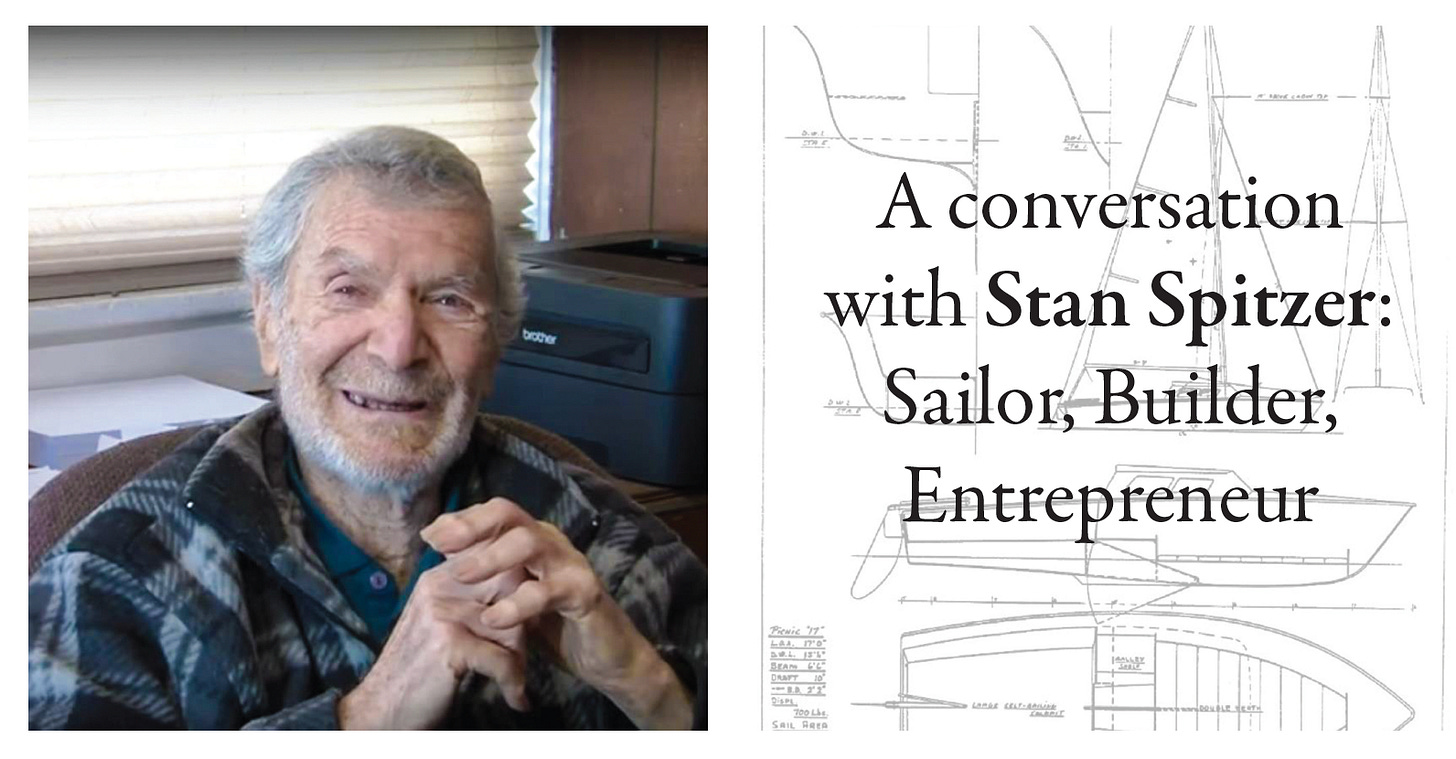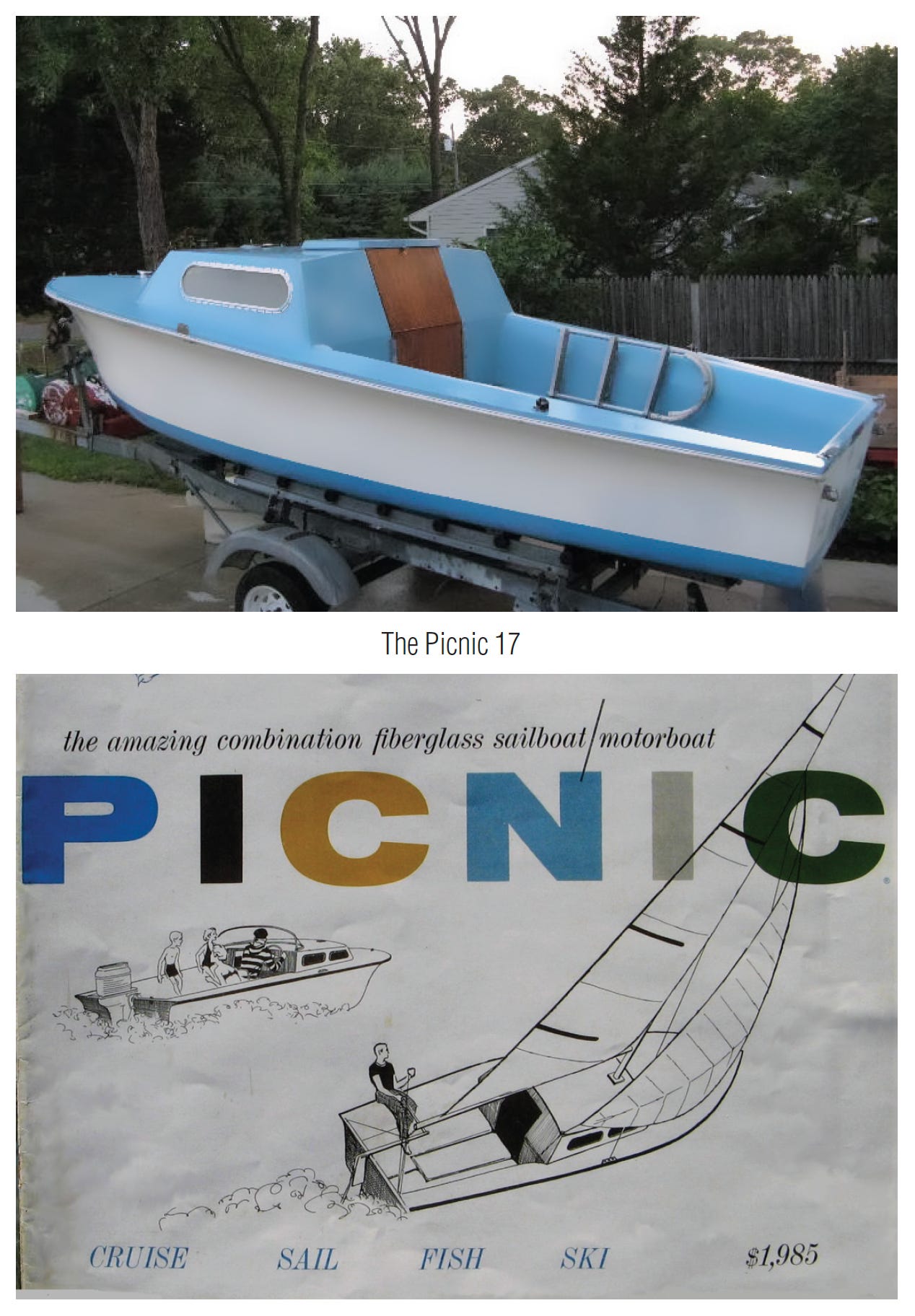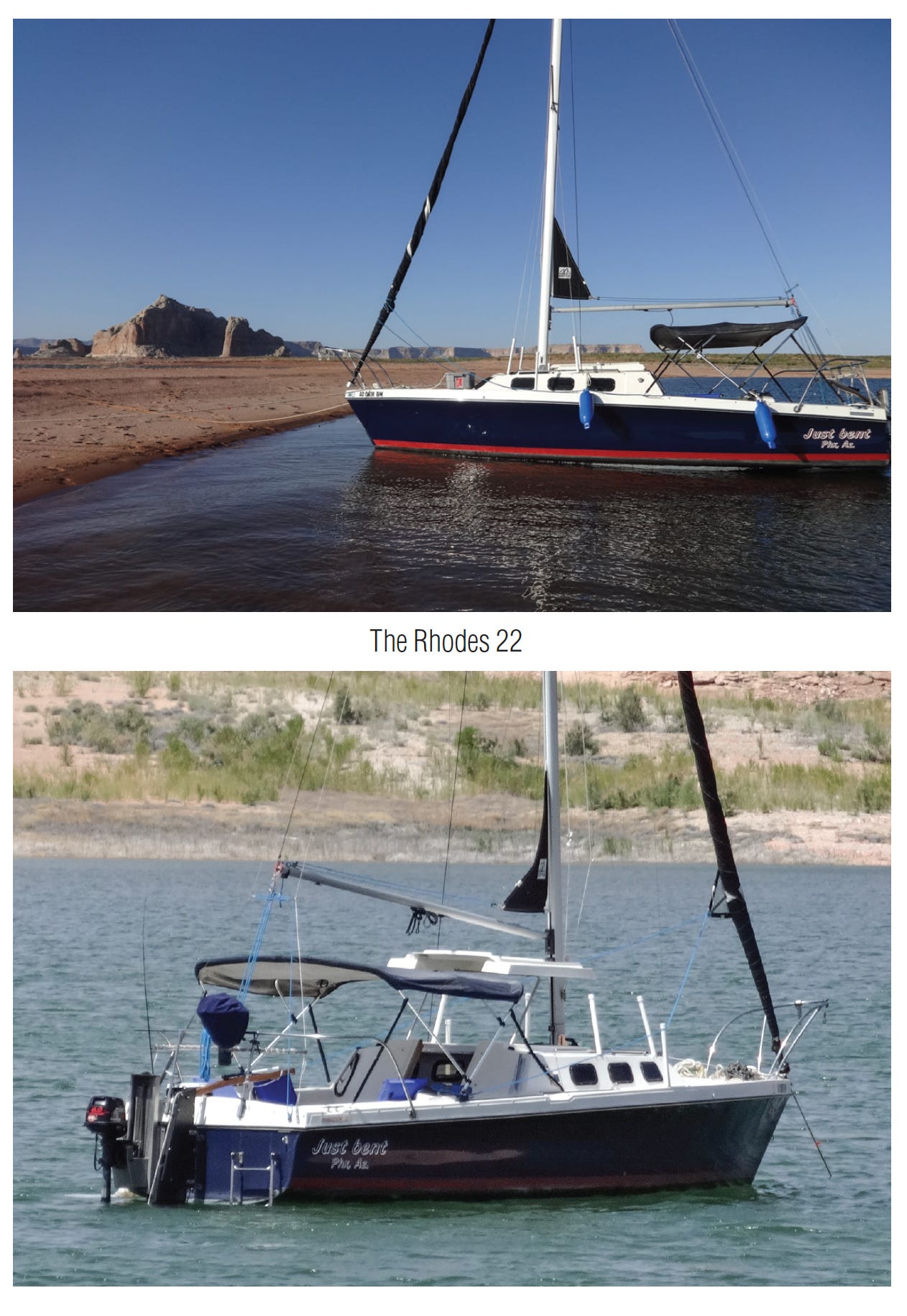I had the opportunity to talk with Stan Spitzer, owner of General Boats, in January of 2016 at his General Boats Plant in Edenton, North Carolina. General Boats has been in the sailboat business since 1959 and is best known for the Rhodes 22. Stan is 90 years old and continues to manage the day to day operations of General Boats.—Jerry Thompson
Why and when did you break into the sailboat business?
I enjoyed sailing and it seemed like a good business to get into. I started by thinking about names. I thought an Atom line of sailboats would be nice—Atom, 20, Atom 25 etc. In those days, the late 40s, the bomb had been dropped and atomic energy was a big deal. Sometime later I bumped into a friend from high school who had served in France during the war. He told me that they were doing great things with sailboats in France and why don’t we import some? I said sure, what have I got to lose? We kept our jobs and formed a company called Nordica Corporation. He flew to France and made arrangements to bring back a sailboat. The first we imported was a Corsaire designed by Herbulot, a famous French designer. It sailed well, but did not hold up. It was made of plywood and the French were behind the United States in technology. I took one to the New York Boat Show which at the time was the only boat show going. And it was gigantic. I was in advertising so I wrote the copy and made up a brochure. Time magazine came by our booth and wrote us up. The show was mostly motorboats with very few sailboats—sailboats where just not that big at the time. My partners had a meeting after the show and told me that I was out. Something about me and my style didn’t sit well with them so they returned my initial $6,000 investment and I was out of Nordica Corporation. Years later I ran into one of my old partners and he told me to not feel bad about being thrown out as they went out of business shortly after kicking me out and lost all their investment.
How did you move on from that disappointing start?
Well, I was hooked after that first boat show. But I had to start from scratch. The graphic artist I worked with at the agency said he liked sailboats, so together we formed General Boats in 1959 keeping our day jobs of course. This was way before Hunter and Catalina and we even beat O’Day into the business. About this time sailing was starting to take off so our timing was good.
How did you decide on the name General Boats?
I always thought big. So I looked around and said I’ll take the best name I can find. There was General Motors, General Electric, General Dynamics so I thought I would try General Boats. I was afraid somebody already had it, but they didn’t. It was free so we had our name.
What was your first boat?
I sought out a naval architect I had heard of, Nils Lucander. Nils did not have a name in those days as he was just starting out. So I asked him to design a sailboat and he said sure I’ll do it and he did it for practically nothing. And so we came out with the Picnic 17. I wrote the copy for a brochure. The graphic artist I worked with did the artwork and it was a beautiful brochure. But the boat wasn’t so hot. From my point of view I wanted it to do everything to appeal to a broad market. We headlined it as a sailboat, motorboat, ski boat, fishing boat. And I found out people who came to the show didn’t know what to buy so they brought their experts with them who were sailors. And they would say it cannot be all those things; a sailboat is a sailboat and a motorboat is a motorboat. I was claiming too much.
Did you produce the Picnic 17?
No, producing as that was the last thing I wanted to do. I was smart enough to know not to get involved with building the boat, let somebody else do that. I was approached by Lofland Sail-Craft out of Wichita, Kansas. They sought me out and said they would like to build the Picnic 17 for me. Francis Lofland was a lovely guy and began producing the Picnic 17 for me. But I couldn’t get enough out of him. He had his own business building the Snipe and other boats, so I was at the bottom of the list. So I went to another company. I went to Ray Greene who was building the Rebel 16 and a line of boats. He started building the Picnic 17 for me, but the same thing happened: I couldn’t get enough. Ray Greene didn’t turn out a good boat. His own boats were okay, but I was not his priority. It was hard to get them to put their heart and soul into a product that wasn’t theirs. I went to another company in Nova Scotia, Industrial Shipping Company Limited, and they were wonderful. They got into building the Picnic 17 and built them fast and very well. But then the guy I was dealing with there, George McGovern, who was a very nice guy, died, ending my deal with that company as he was the guy who wanted to build the Picnic for me. It was one thing after another. So I decided at that point if I was going to stay in this business I have got to make a boat that has a reputation behind it. Nils Lucander would become a big name eventually, but at that point customers would ask who the Picnic was designed by and I would tell them Nils Lucander, but they never heard of him. So I had to get a name behind me.
How many Picnic 17s did you sell?
We ended up selling 350 which encouraged us to stay in the business, but we needed a name. Roger McGregor saw the Picnic 17 at a show and told me he liked the notion of a sailboat/motorboat. This was before he was building sailboats, but he put that idea back in his mind and eventually produced his own line of motorsailors. We became very good friends over the years. He was a very smart guy, top in his class at Stanford.
What came after the Picnic 17?
I needed something new. The naval architects in those days didn’t charge based upon their reputations but by the size of the boat they were designing. At that time the number one reputation belonged to Phillip Rhodes. So I decided that’s easy, you start at the top and when he says no you work your way down. His office was on Lexington Avenue also in New York City where I was living. So I made up some sketches and went and knocked on his door and he answered. There were lots of people working there, it was a big firm, but he answered the door. He looked down on me and said “What do you want?” I said I would like you to design a boat for me. I showed him the sketches. At that time he would get a call from the Rockefellers saying hey Phil I need a 55-foot yacht, and he would design it for them. But there I was with sketches of a 22-foot boat and here is this guy a very well known, famous naval architect. And he said, “You know what, I have not designed a smaller boat in a long time, I think I want to do this.” I almost fell over. And I worked with him a year in his office and I learned a lot about designing. Of course he would turn it over to somebody else and he would walk around like a school teacher making suggestions, changes and corrections.
Was it expensive to have the top naval architect of the time design your boat?
There were two ways you could work with Phillip Rhodes. You could say it was your product and pay a royalty on each hull produced, or you could say I’ll commission you and pay you a flat fee and it is my product. I said I’d rather own it outright and he said fine.
The Rhodes 22 has a very unique hull flare. Was that your idea or Phillip’s?
I was always looking at other boats and one was an Olympic racing boat, the 505. It had what was called an upside down wineglass shape to the hull. And so I wondered about that flare and started thinking about it from an engineering point of view. And it began to dawn on me it had a lot of advantages. First, it had a built in hiking seat. You could sit out on the flare beyond the hull itself, you could carry more sail and keep the boat flat, I liked that idea. Then I thought it also makes a very dry hull. In a regular sailboat the waves break over the side and into the cockpit, a wave hits the flare and goes out away from the cockpit—very dry. I looked at it more and recognized that because it was a compound curve instead of a simple curve, it would be very strong. So using the same fiberglass the other guys use I would have a much stronger hull. The sketches I gave to Phil had the flare and he told me he liked what I was doing, but he didn’t like the flare, “That’s a motorboat, doesn’t look like a sailboat.” He didn’t like it, but I insisted and he said it was my money so I could go for it. After working on it a while Phil said the flare was growing on him. By the time he finished he said he liked it.
I have heard the boat referred to as the Rhodes Continental.
When I was first thinking about names the Lincoln Continental was a very popular automobile, so I tried Rhodes Continental, two big names. But I changed that not too long after to the Rhodes 22.
How was the Rhodes 22 received by the public?
I had a model made and brought it to the New York boat show, and when people saw it they either didn’t like it because it looked like a motorboat or they loved it; it was extremes. I didn’t need the whole market, I just needed a piece. It came out for $2,500. I put a big red ribbon around it. You got the boat, the sails, the cushions, the lines, everything. With all other sailboats everything was extra, the price sheet on sailboats in those days was pages. I came out with a price for the whole package and that worked. I started taking orders.
What year was that?
Phil designed the boat in 1968 and we began having them produced in 1970.
What do you most enjoy about the sailboat business?
The customers. My customers have all been wonderful. Well, once there was a guy who was a pain in the neck. He came to my office and I sat him down and got out my checkbook and started writing. He said what are you doing? I said I’m giving you your money back. He said I don’t want the money; I want your boat. So I told him to stop being such a pain in the neck and he agreed. And there was one other guy who liked the boat and bought it, but came back and said his family didn’t take to it and asked if I would take it back. I said yes I’ll give you all of your money back. He said you’ll give all my money back? I said sure. I don’t want anybody sailing the boat who isn’t happy with it. I always tell my customers that they are our sales force. We don’t sell through dealers. So you’ve got to be happy with the boat. If you are not happy, I’m not going to let you keep it.
How many Rhodes 22s have been built?
2,500. That is not an exact number as through the years we lost track of a few, but at least 2,500.
Tell me about your recycled boats?
As the sales of new boats dropped off I started thinking of ways to make up for it. So I came up with the recycled boat program. We would purchase older hulls, go completely over them, and sell them for much less than a new boat. And they look and perform like new boats. I have a boat out in the yard now that is 30 years old and a customer the other day thought it was new. The recycled boats kept us in business. But it was a double-edged sword as it hurt further the new boat business. But, we are still in business.
Are you the only builder that has a recycle program?
To my knowledge, yes. The reason it worked is that we sold direct. It would not work if you sold through dealers, which most builders do.
Did you go to Annapolis this year?
Yes, we were at the first show in1970 and have not missed a single show.
You have shown at every Annapolis Boat Show?
Yes, we’ve worked our way up from being way in the rear end of the show to what I call the prime corner location. We have shown at 45 shows and hope to make 50. •SCA•
Stan Spitzer and the Rhodes 22 have a very strong following of owners, known as Rhodies, who are fiercely loyal to Stan and the Rhodes 22. Stan is still selling new and recycled Rhodes 22s at his plant in Edenton, North Carolina.
Jerry Thompson is an Information Systems professional who works and lives in eastern North Carolina. He learned to sail over 25 years ago at the Armed Forces Recreation Center, Lake Chiemsee, Germany. North Carolina’s milder winters keep Jerry on the water year round.
First appeared in issue #109






FYI Those of us on the Rhodes 22 owners email list received this notice from Stan's daughter Cindy on June 19. She said
"Stanley Spitzer – the creator and relentless innovator of the Rhodes 22
sailboat; the inventor of the earlier Picnic 17; the love of Rose Spitzer’s
life for more than 70 years; father of Cindy, Scott, and Skip Spitzer; dear
brother of Elton Spitzer (also a legend in his time); the impossibly
precocious first born of Harold and Gertrude Spitzer; the Purdue University
trained electrical engineer, self-taught Madison Avenue copywriter,
management consultant, wire recorder salesman, and builder of mid-century
homes so unconventional he had to go to court to defend his roof lines; the
98-year-old World War II Navy veteran; the perpetually young risk-taker who
never saw a mountain too tall or a dream too distant; the skinny can-do kid
from Brooklyn who dragged a sunken sailboat out of Sheepshead Bay and
thought he would live forever – has died.
Every person is a universe. A solar system of friends, relatives, and
countless people we touch in countless way, often without fully knowing who
or how much.
And every death is a universe imploding. A world and all its stories
suddenly gone.
No words can capture a person’s life. Just know that if you are reading
this right now, that means you – the full, evolving universe of you –
intersected with Stan in some way and left your mark. As he certainly left
his on us."
On June 20 she added:
"Just a quick note to confirm that the GB Parts Department is still open and
functioning (via Charles Gabriel). General Boats has everything from sails
to hard to find replacement parts and many other items you may need to
repair or upgrade your boat. We also have some used Rhodes available in
Edenton, NC, if anyone has an interested.
Thank you again for all your kind words, great stories, and memories
through the years.
A memorial for Stan may be held at this fall's Annapolis Sailboat Show,
where he was an exhibitor for more than 50 years. I will send updates as I
know more."
Stan died last month but had a great inning and left us with an excellent boat!